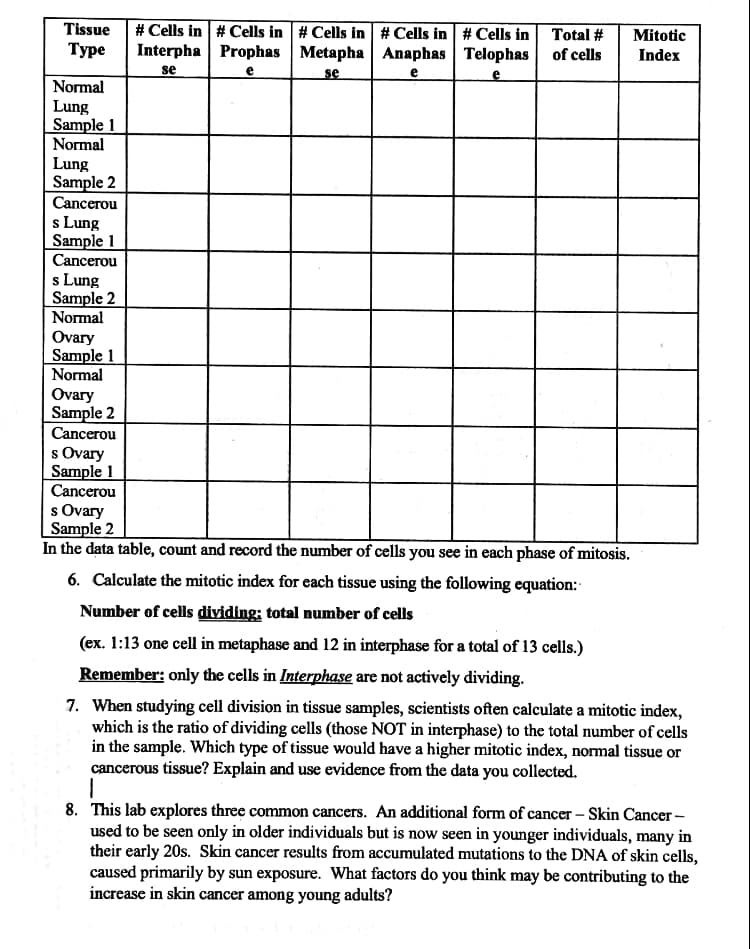# Cells in # Cells in # Cells in # Cells in # Cells in Interpha Prophas Metapha Anaphas Telophas Tissue Total # Mitotic Туре of cells Index se se e Normal Lung Sample 1 Normal Lung Sample 2 Cancerou s Lung Sample 1 Cancerou s Lung Sample 2 Normal Ovary Sample 1 Normal Ovary Sample 2 Cancerou s Ovary Sample 1 Cancerou s Ovary Sample 2 In the data table, count and record the number of cells you see in each phase of mitosis. 6. Calculate the mitotic index for each tissue using the following equation: Number of cells dividing: total number of cells (ex. 1:13 one cell in metaphase and 12 in interphase for a total of 13 cells.) Remember: only the cells in Interphase are not actively dividing. 7. When studying cell division in tissue samples, scientists often calculate a mitotic index, which is the ratio of dividing cells (those NOT in interphase) to the total number of cells in the sample. Which type of tissue would have a higher mitotic index, normal tissue or cancerous tissue? Explain and use evidence from the data you collected.
# Cells in # Cells in # Cells in # Cells in # Cells in Interpha Prophas Metapha Anaphas Telophas Tissue Total # Mitotic Туре of cells Index se se e Normal Lung Sample 1 Normal Lung Sample 2 Cancerou s Lung Sample 1 Cancerou s Lung Sample 2 Normal Ovary Sample 1 Normal Ovary Sample 2 Cancerou s Ovary Sample 1 Cancerou s Ovary Sample 2 In the data table, count and record the number of cells you see in each phase of mitosis. 6. Calculate the mitotic index for each tissue using the following equation: Number of cells dividing: total number of cells (ex. 1:13 one cell in metaphase and 12 in interphase for a total of 13 cells.) Remember: only the cells in Interphase are not actively dividing. 7. When studying cell division in tissue samples, scientists often calculate a mitotic index, which is the ratio of dividing cells (those NOT in interphase) to the total number of cells in the sample. Which type of tissue would have a higher mitotic index, normal tissue or cancerous tissue? Explain and use evidence from the data you collected.
Essentials of Pharmacology for Health Professions
7th Edition
ISBN:9781305441620
Author:WOODROW
Publisher:WOODROW
Chapter6: Safe Dosage Calculations
Section: Chapter Questions
Problem B.3CRQ
Related questions
Question
Hi I need help for this table with that 3 Q here is the link
http://glencoe.mheducation.com/sites/dl/free/0078802849/383933/BL_23.html


Transcribed Image Text:# Cells in # Cells in # Cells in # Cells in # Cells in
Interpha Prophas Metapha Anaphas Telophas
Tissue
Total #
Mitotic
Туре
of cells
Index
se
se
e
Normal
Lung
Sample 1
Normal
Lung
Sample 2
Cancerou
s Lung
Sample 1
Cancerou
s Lung
Sample 2
Normal
Ovary
Sample 1
Normal
Ovary
Sample 2
Cancerou
s Ovary
Sample 1
Cancerou
s Ovary
Sample 2
In the data table, count and record the number of cells you see in each phase of mitosis.
6. Calculate the mitotic index for each tissue using the following equation:
Number of cells dividing: total number of cells
(ex. 1:13 one cell in metaphase and 12 in interphase for a total of 13 cells.)
Remember: only the cells in Interphase are not actively dividing.
7. When studying cell division in tissue samples, scientists often calculate a mitotic index,
which is the ratio of dividing cells (those NOT in interphase) to the total number of cells
in the sample. Which type of tissue would have a higher mitotic index, normal tissue or
cancerous tissue? Explain and use evidence from the data you collected.
Expert Solution
This question has been solved!
Explore an expertly crafted, step-by-step solution for a thorough understanding of key concepts.
This is a popular solution!
Trending now
This is a popular solution!
Step by step
Solved in 3 steps

Knowledge Booster
Learn more about
Need a deep-dive on the concept behind this application? Look no further. Learn more about this topic, biology and related others by exploring similar questions and additional content below.Recommended textbooks for you

Essentials of Pharmacology for Health Professions
Nursing
ISBN:
9781305441620
Author:
WOODROW
Publisher:
Cengage

Essentials of Pharmacology for Health Professions
Nursing
ISBN:
9781305441620
Author:
WOODROW
Publisher:
Cengage